JVCKENWOOD 478600 UHF FM TRANSCEIVER User Manual 1 of 2
JVC KENWOOD Corporation UHF FM TRANSCEIVER Users Manual 1 of 2
Contents
- 1. Users Manual - 1 of 2
- 2. Users Manual - 2 of 2
Users Manual - 1 of 2

INSTRUCTION MANUAL
TK-3230DX
B5A-1297-00 (K)

2
CONTENTS
FEATURES ....................................................................... 4
OPERATING CONDITIONS.....................................................................4
NOTICES TO THE USER ....................................................... 5
FCC LICENSE INFORMATION ................................................................6
PRECAUTIONS ......................................................................................7
UNPACKING AND CHECKING EQUIPMENT ................................12
SUPPLIED ACCESSORIES...................................................................12
PREPARATION .................................................................12
INSTALLING/ REMOVING THE BATTERY PACK ..................................12
CHARGING THE BATTERY PACK .........................................................13
INSTALLING THE BELT CLIP ...............................................................14
INSTALLING THE OPTIONAL SPEAKER/ MICROPHONE
(OR HEADSET) ....................................................................................14
ORIENTATION ..................................................................15
DISPLAY .............................................................................................16
BASIC OPERATION ............................................................17
QUIET TALK/ DIGITAL QUIET TALK .........................................18
PRIVACY TALK .................................................................21
TRANSMIT POWER ...........................................................21
COMPANDER ..................................................................22
MONITOR.......................................................................22
LOCK FUNCTION ..............................................................23
KEY LOCK ..........................................................................................23
SUPER LOCK ......................................................................................23
SETTING MODE ................................................................24
CHANNEL FREQUENCY SETUP ..............................................26
SCAN ............................................................................ 27
REVERT CHANNEL ..............................................................................28
THANK YOU
We are grateful for your purchase of this KENWOOD product
and welcome you to the Business Radio Service (BRS).

3
SQUELCH LEVEL ..............................................................28
VOICE OPERATED TRANSMISSION (VOX) .................................29
VOX OPERATION.................................................................................29
VOX Gain Level ...............................................................................29
VOX Delay Time ..............................................................................30
Transmit Inhibit While Receiving .....................................................30
VOX Proceed Tone ..........................................................................31
FleetSync: ALPHANUMERIC 2-WAY PAGING FUNCTION ................32
CALL KEY SETUP ................................................................................32
CALL ALERT TONE ..............................................................................33
Call Alert Side Tone .........................................................................33
SELCALL (SELECTIVE CALLING) ........................................................34
Making a Selcall ..............................................................................36
Receiving a Selcall ..........................................................................37
Data Transmit Modulation Delay Time .............................................38
PTT ID .............................................................................................38
PTT ID Side Tone ............................................................................39
Mute Hold Time...............................................................................39
Caller ID Display ..............................................................................40
BACKGROUND OPERATIONS ................................................40
DISPLAY BACKLIGHT .........................................................................40
MIC SENSE .........................................................................................41
TIME-OUT TIMER ...............................................................................41
BATTERY SAVER .................................................................................42
BATTERY LEVEL INDICATOR ..............................................................43
INCOMING CALL NOTIFICATION .........................................................44
BUSY CHANNEL LOCKOUT (BCL) .......................................................44
BEEP TONE .........................................................................................45
MODE RESET TIMER ..........................................................................45
SELECTABLE POWER ON TONE ..........................................................46
RESETTING THE TRANSCEIVER .............................................46
TROUBLESHOOTING GUIDE .................................................47
SPECIFICATIONS ..............................................................48

4
FEATURES
• Lightweight and compact design using a lithium-ion battery pack,
with a sturdy, polycarbonate body and a spring-loaded belt clip.
• 219 tone/code settings for each channel, allowing you to ignore
unwanted calls.
• Privacy Talk scrambles all your voice messages, giving you
complete privacy for your conversations.
• FleetSync operation, allowing a variety of call types.
• Automatic battery power saver, providing you with longer battery
usage.
• Battery power level indicator with low battery power warning.
• Key lock and Super Lock prevent you from accidentally changing
your transceiver settings.
• Ten different calling alert tones allows you to identify yourself to your
group before you begin speaking.
• Hands free operation when using an optional headset.
• Selectable Power ON Tone.
OPERATING CONDITIONS
Open locations (no obstructions) Up to 5 miles (8 km)
Residential areas (near buildings) Up to 1.5 miles (2.4 km)
In steel/ concrete reinforced buildings
Up to 225,000 ft2 (20,900 m2)
In high rises Up to 17 fl oors
Note:
◆The listed ranges are based on fi eld testing and may vary with your
operating conditions.
Firmware Copyrights
The title to and ownership of copyrights for fi rmware embedded in KENWOOD
product memories are reserved for JVC KENWOOD Corporation.

5
NOTICES TO THE USER
◆Refer service to qualifi ed technicians only.
Safety: It is important that the operator is aware of, and
understands, hazards common to the operation of any
transceiver.
One or more of the following statements may be applicable:
FCC WARNING
This equipment generates or uses radio frequency energy. Changes or
modifications to this equipment may cause harmful interference unless
the modifications are expressly approved by the party responsible/
JVC KENWOOD. The user could lose the authority to operate this
equipment if an unauthorized change or modification is made.
INFORMATION TO THE DIGITAL DEVICE USER REQUIRED BY THE
FCC
This equipment has been tested and found to comply with the limits for
a Class B digital device, pursuant to Part 15 of the FCC Rules. These
limits are designed to provide reasonable protection against harmful
interference in a residential installation.
This equipment generates, uses and can generate radio frequency
energy and, if not installed and used in accordance with the instructions,
may cause harmful interference to radio communications. However,
there is no guarantee that the interference will not occur in a particular
installation. If this equipment does cause harmful interference to radio or
television reception, which can be determined by turning the equipment
off and on, the user is encouraged to try to correct the interference by
one or more of the following measures:
• Reorient or relocate the receiving antenna.
• Increase the separation between the equipment and receiver.
• Connect the equipment to an outlet on a circuit different from that to
which the receiver is connected.
• Consult the dealer for technical assistance.

6
FCC LICENSE INFORMATION
Your KENWOOD transceiver operates on communications
frequencies which are subject to FCC (Federal
Communications Commission) Rules & Regulations. FCC
Rules require that all operators using Private Land Mobile
radio frequencies obtain a radio license before operating their
equipment. Application for license must be made on FCC form
601, schedules D and H, and Remittance form 159.
FAX: Forms can be obtained by fax from the FCC Fax-On-
Demand system. Call 1-202-418-0177 from your fax machine
and request document number 000601 for the form, schedules,
and instructions.
MAIL: Forms can be ordered by telephone, and will be sent to
you by fi rst class mail. Call the FCC Forms Hotline at 1-800-
418-FORM (1-800-418-3676).
INTERNET: Form 601 and instructions can be downloaded
from the FCC Forms website at
http://www.fcc.gov/formpage.html
Before fi lling out your Form 601 application Technical Data
section, you must decide on which frequencies you will operate.
See the frequency charts on page 26.
QUESTIONS? Call the FCC for license application questions at
1-888-CALL-FCC (1-888-225-5322).
ATTENTION:
The RBRC Recycle seal found on KENWOOD
lithium-ion (Li-ion) battery packs indicates
KENWOOD’s voluntary participation in an
industry program to collect and recycle
Li-ion batteries after their operating life has
expired. The RBRC program is an alternative
to disposing Li-ion batteries with your regular
refuse or in municipal waste streams, which is
illegal in some areas.
For information on Li-ion battery recycling in your area, call (toll free)
1-800-8-BATTERY (1-800-822-8837).
KENWOOD’s involvement in this program is part of our commitment to
preserve our environment and conserve our natural resources.
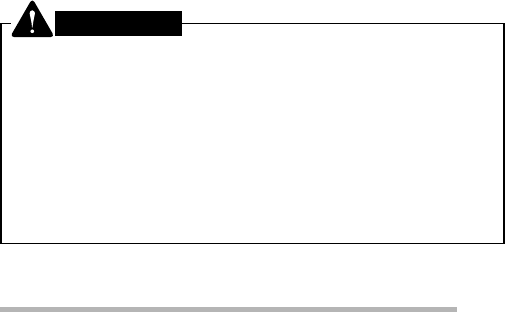
7
PRECAUTIONS
• Do not charge the transceiver and battery pack when they are wet.
• Ensure that there are no metallic items located between the
transceiver and the battery pack.
• Do not use options not specifi ed by KENWOOD.
• If the die-cast chassis or other transceiver part is damaged, do not
touch the damaged parts.
• If a headset or headphone is connected to the transceiver, reduce
the transceiver volume. Pay attention to the volume level when
turning the squelch off.
• Do not place the microphone cable around your neck while near
machinery that may catch the cable.
• Do not place the transceiver on unstable surfaces.
• Ensure that the end of the antenna does not touch your eyes.
• When the transceiver is used for long transmissions, the radiator
and chassis will become hot. Do not touch these locations when
replacing the battery pack.
• Do not immerse the transceiver in water.
• Always switch the transceiver power off before installing optional
accessories.
• To dispose of batteries, be sure to comply with the laws and
regulations in your country or region.
WARNING
Turn the transceiver power off in the following locations:
• In explosive atmospheres (infl ammable gas, dust particles,
metallic powders, grain powders, etc.).
• While taking on fuel or while parked at gasoline service stations.
• Near explosives or blasting sites.
• In aircraft. (Any use of the transceiver must follow the
instructions and regulations provided by the airline crew.)
• Where restrictions or warnings are posted regarding the use of
radio devices, including but not limited to medical facilities.
• Near persons using pacemakers.

8
CAUTION
• Do not disassemble or modify the transceiver for any reason.
• Do not place the transceiver on or near airbag equipment while
the vehicle is running. When the airbag infl ates, the transceiver
may be ejected and strike the driver or passengers.
• If an abnormal odor or smoke is detected coming from the
transceiver, switch the transceiver power off immediately,
remove the battery pack from the transceiver, and contact your
KENWOOD dealer.
• Use of the transceiver while you are driving may be against traffi c
laws. Please check and observe the vehicle regulations in your
area.
• Do not expose the transceiver to extremely hot or cold
conditions.
• Do not carry the battery pack with metal objects, as they may
short the battery terminals.
• Danger of explosion if the battery is incorrectly replaced; replace
only with the same type.
• When attaching a commercial strap to the transceiver, ensure
that the strap is durable. In addition, do not swing the transceiver
around by the strap; you may inadvertently strike and injure
another person with the transceiver.
• If a commercially available neck strap is used, take care not to
let the strap get caught on nearby machine.
• When operating the transceiver in areas where the air is dry, it is
easy to build up an electric charge (static electricity). When using
an earphone accessory in such conditions, it is possible for the
transceiver to send an electric shock through the earphone and
to your ear. We recommend you use only a speaker/microphone
in these conditions, to avoid electric shocks.
• Do not expose the transceiver to long periods of direct sunlight,
nor place it near heating appliances.

9
Information concerning the battery pack:
The battery pack includes fl ammable objects such as organic
solvent. Mishandling may cause the battery to rupture
producing fl ames or extreme heat, deteriorate, or cause other
forms of damage to the battery. Please observe the following
prohibitive matters.
DANGER
• Do not disassemble or reconstruct battery!
The battery pack has a safety function and protection circuit to avoid
danger. If they suffer serious damage, the battery may generate heat
or smoke, rupture, or burst into fl ame.
• Do not short-circuit the battery!
Do not join the + and – terminals using any form of metal (such as a
paper clip or wire). Do not carry or store the battery pack in containers
holding metal objects (such as wires, chain-necklaces or hairpins). If
the battery pack is short-circuited, excessive current will fl ow and the
battery may generate heat or smoke, rupture, or burst into fl ame. It will
also cause metal objects to heat up.
• Do not incinerate or apply heat to the battery!
If the insulator is melted, the gas release vent or safety function is
damaged, or the electrolyte is ignited, the battery may generate heat
or smoke, rupture, or burst into fl ame.
• Do not leave the battery near fi re, stoves, or other heat
generators (areas reaching over 80°C/ 176°F)!
If the polymer separator is melted due to high temperature, an
internal short-circuit may occur in the individual cells and the battery
may generate heat or smoke, rupture, or burst into fl ame.
• Do not immerse the battery in water or get it wet by other
means!
If the battery’s protection circuit is damaged, the battery may charge
at extreme current (or voltage) and an abnormal chemical reaction
may occur. The battery may generate heat or smoke, rupture, or
burst into fl ame.
• Do not charge the battery near fi re or under direct sunlight!
If the battery’s protection circuit is damaged, the battery may charge
at extreme current (or voltage) and an abnormal chemical reaction
may occur. The battery may generate heat or smoke, rupture, or
burst into fl ame.

10
DANGER
• Use only the specifi ed charger and observe charging
requirements!
If the battery is charged in unspecifi ed conditions (under high
temperature over the regulated value, excessive high voltage or
current over regulated value, or with a remodeled charger), it may
overcharge or an abnormal chemical reaction may occur. The battery
may generate heat or smoke, rupture, or burst into fl ame.
• Do not pierce the battery with any object, strike it with an
instrument, or step on it!
This may break or deform the battery, causing a short-circuit. The
battery may generate heat or smoke, rupture, or burst into fl ame.
• Do not jar or throw the battery!
An impact may cause the battery to leak, generate heat or smoke,
rupture, and/or burst into fl ame. If the battery’s protection circuit
is damaged, the battery may charge at an abnormal current (or
voltage), and an abnormal chemical reaction may occur. The battery
may generate heat or smoke, rupture, or burst into fl ame.
• Do not use the battery pack if it is damaged in any way!
The battery may generate heat or smoke, rupture, or burst into
fl ame.
• Do not solder directly onto the battery!
If the insulator is melted or the gas release vent or safety function is
damaged, the battery may generate heat or smoke, rupture, or burst
into fl ame.
• Do not reverse the battery polarity (and terminals)!
When charging a reversed battery, an abnormal chemical reaction
may occur. In some cases, an unexpected large amount of current
may fl ow upon discharging. The battery may generate heat or
smoke, rupture, or burst into fl ame.
• Do not reverse-charge or reverse-connect the battery!
The battery pack has positive and negative poles. If the battery pack
does not smoothly connect with a charger or operating equipment,
do not force it; check the polarity of the battery. If the battery pack is
reverse-connected to the charger, it will be reverse-charged and an
abnormal chemical reaction may occur. The battery may generate
heat or smoke, rupture, or burst into fl ame.

11
DANGER
• Do not touch a ruptured and leaking battery!
If the electrolyte liquid from the battery gets into your eyes, wash
your eyes with fresh water as soon as possible, without rubbing your
eyes. Go to the hospital immediately. If left untreated, it may cause
eye-problems.
WARNING
• Do not charge the battery for longer than the specifi ed time!
If the battery pack has not fi nished charging even after the regulated
time has passed, stop it. The battery may generate heat or smoke,
rupture, or burst into fl ame.
• Do not place the battery pack into a microwave or high
pressure container!
The battery may generate heat or smoke, rupture, or burst into
fl ame.
• Keep ruptured and leaking battery packs away from fi re!
If the battery pack is leaking (or the battery emits a bad odor),
immediately remove it from fl ammable areas. Electrolyte leaking
from battery can easily catch on fi re and may cause the battery to
generate smoke or burst into fl ame.
• Do not use an abnormal battery!
If the battery pack emits a bad odor, appears to have different
coloring, is deformed, or seems abnormal for any other reason,
remove it from the charger or operating equipment and do not use
it. The battery may generate heat or smoke, rupture, or burst into
fl ame.
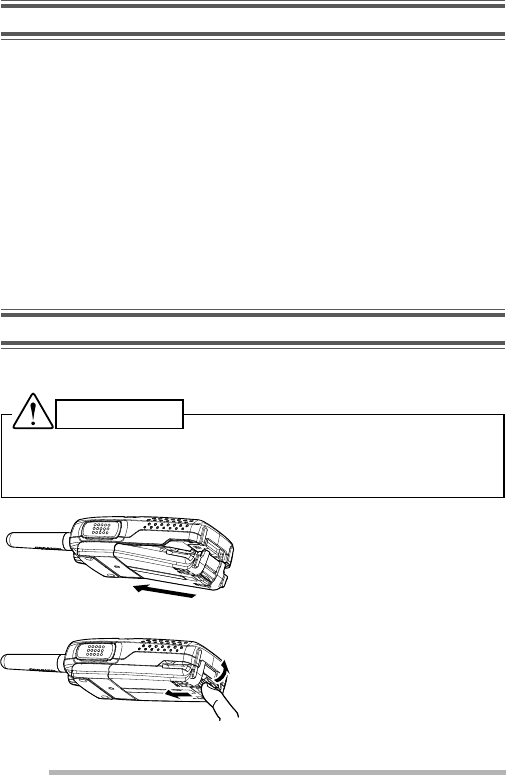
12
UNPACKING AND CHECKING EQUIPMENT
Carefully unpack the transceiver. If any of the items listed
below are missing or damaged, fi le a claim with the carrier
immediately.
SUPPLIED ACCESSORIES
• Battery charger/ AC adapter (KSC-37S) ................................1
• Li-ion Battery pack (KNB-46L) ................................................ 1
• Belt clip (KBH-14) ................................................................... 1
• Screw (M3 x 8 mm) ................................................................2
• Warranty card .........................................................................1
• Instruction manual ..................................................................1
PREPARATION
INSTALLING/ REMOVING THE BATTERY PACK
CAUTION
◆Do not short the battery terminals or dispose of the battery by
fi re.
◆Never attempt to remove the casing from the battery pack.
1 Match the guides of the
battery pack with the
corresponding grooves on the
upper rear of the transceiver,
then fi rmly press the battery
pack to lock it in place.
2 To remove the battery pack, lift
the safety catch on the base
of the transceiver, then press
the release latch underneath
the safety catch.
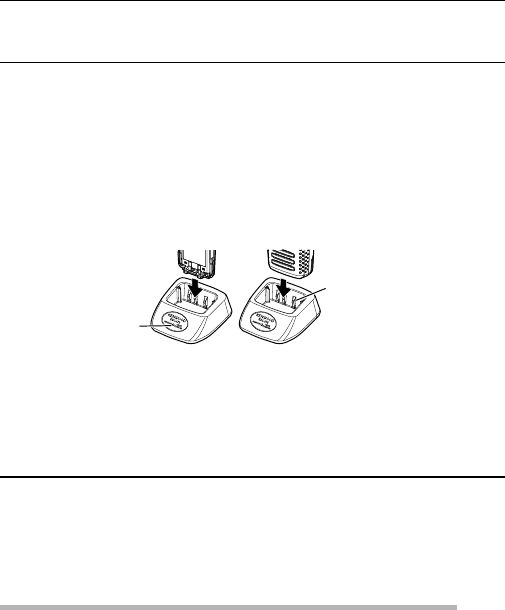
13
CHARGING THE BATTERY PACK
The battery pack is not charged at the factory; charge it before
use.
Average battery pack life:
Battery Saver on: 18 hours/ Battery Saver off: 14 hours
• Average times are calculated using 5% transmit time, 5% receive
time, and 90% standby time.
ATTENTION:
◆Always switch OFF a transceiver equipped with a battery pack
before inserting the transceiver into the charger.
1 Plug the AC adapter cable into the jack located on the rear
of the charger.
2 Plug the AC adapter into an AC outlet.
3 Slide a battery pack or a transceiver equipped with a battery
pack into the charging slot of the charger.
• Make sure the metal contacts of the battery pack mate securely
with the charger metal terminals.
• The indicator lights red and charging begins.
Indicator
Charger metal
terminals
4 When charging is completed, the indicator fl ashing green.
Remove the battery pack or the transceiver from the
charging slot of the charger.
• It takes approximately 2.5 hours to charge the battery pack.
• When the charger will not be used for a long time, unplug the AC
adapter from the AC outlet.
Note:
◆When the indicator blinks red, the battery pack is either defective or
the battery pack contacts are not properly mated with those of the
charger.

14
◆The ambient temperature should be between 41°F and 104°F (5°C
and 40°C) while charging is in progress. Charging outside this range
may not fully charge the battery.
◆The battery pack life is over when its operating time decreases even
though it is fully and correctly charged. Replace the battery pack.
INSTALLING THE BELT CLIP
If necessary, attach the belt clip
using the two supplied M3 x 8 mm
screws.
INSTALLING THE OPTIONAL SPEAKER/ MICROPHONE (OR
HEADSET)
1 Open the SP/MIC tabs on the side of
the transceiver.
2 Insert the accessory’s plugs into the
SP/MIC jacks.
3 When you remove the accessory
from the transceiver, be sure to
cover the SP/MIC jacks with the
attached tabs, in order to keep dust
and dirt away from the contacts.

15
ORIENTATION
df
e
b a
h
c
g
Microphone
Speaker
Antenna
a Power switch/ Volume control
Turn clockwise to switch ON the transceiver. To switch OFF
the transceiver, turn counterclockwise until a click sounds.
Rotate to adjust the volume level.
b LED indicator
Indicates the transceiver status.
c PTT (Push to Talk) switch
Press and hold, then speak into the microphone to transmit.
d MENU key
Press to perform various functions. Press and hold while
switching the power ON to enter Setting Mode.
e CAL key
Press before making a call to alert the other party members,
or press to select a unit ID to make a call.
f MON key
Press to monitor the current channel for activity.

16
g / keys
Press to change the operating channel, to select a menu in
Setting Mode, and to perform other functions.
h Speaker/ microphone jacks
Insert the Speaker/ microphone or Headset plug into this jack.
DISPLAY
Icon Description
Appears when VOX is activated.
Appears when using low transmit power.
Appears when the channel is set up with a DQT
code.
Appears when making or receiving a selcall.
Displays the approximate battery power
remaining. Blinks when the battery power is
low, while transmitting.
Appears when Privacy Talk is activated.
Appears when the Caller’s ID is displayed.
Displays the channel number along with its
QT/DQT setting (if any). Also displays various
menus and menu settings.
Appears when compander is activated.
Appears while monitoring a channel.
Appears when the transceiver keys have been
locked.
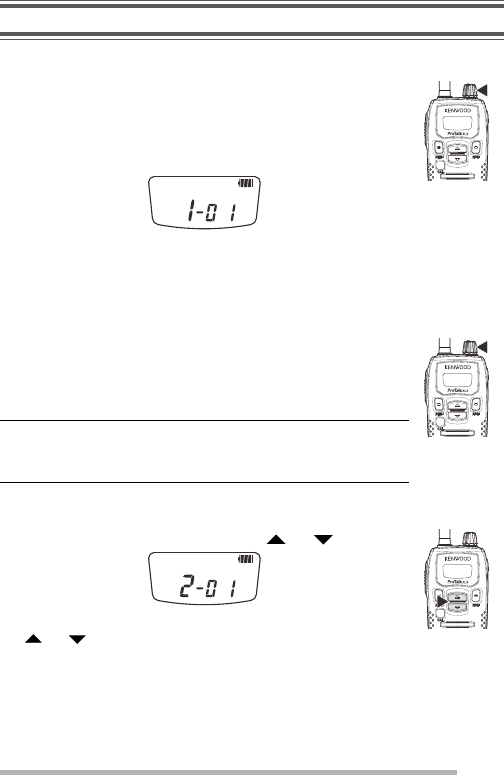
17
BASIC OPERATION
Switch the Power ON
Switch the transceiver power ON by turning the
Power switch/ Volume control clockwise.
• A confi rmation tone sounds, the LCD lights up
momentarily, then the current channel number is
displayed.
To switch the transceiver power OFF, turn
the Power switch/ Volume control fully
counterclockwise, until a click sounds.
Adjust the Volume
Set your desired volume level by rotating the
Power switch/ Volume control.
• Clockwise increases the volume and counterclockwise
decreases the volume.
Note:
◆To adjust the volume using background noise as a
reference, use the Monitor function {page 22}.
Select a Channel
Select a channel by pressing the or key.
• A confi rmation tone sounds each time you press the
or key.
• When you receive a call on your selected channel, you
will hear audio from the speaker and the LED will light
green.
• To use a signaling code, refer to “QUIET TALK/
DIGITAL QUIET TALK” {page 18}.

18
Make a Call
1 Press the MON key to make sure the channel is
not in use {page 22}.
2 Press and release the CAL key to alert the
other parties that you are beginning a call.
• A call alert tone will sound on the other party’s
transceiver.
3 Press and hold the PTT switch, then speak into
the speaker area to transmit.
• The LED lights red while transmitting.
• For best sound quality, speak into the speaker
area in your normal speaking
voice while holding the transceiver approximately
1.5 inches (3 to 4 cm) from your mouth.
4 Release the PTT switch when you have fi nished
speaking.
QUIET TALK/ DIGITAL QUIET TALK
QT (Quiet Talk) and DQT (Digital Quiet Talk) are functions
that reject signals from undesired parties that are using the
same channel as you. You will hear audio from the speaker
only when you receive a signal that contains a tone or code
matching the one set up on the channel you are using.
Likewise, when you transmit on a channel set up with QT or
DQT, the receiving station must have a matching tone or code
in order to hear your signal.
You can select a tone or code for each channel. There are 45
QT tones and 174 DQT codes. After changing the QT/ DQT
setting, confi rm that the other members in your group have
selected the same tone or code.
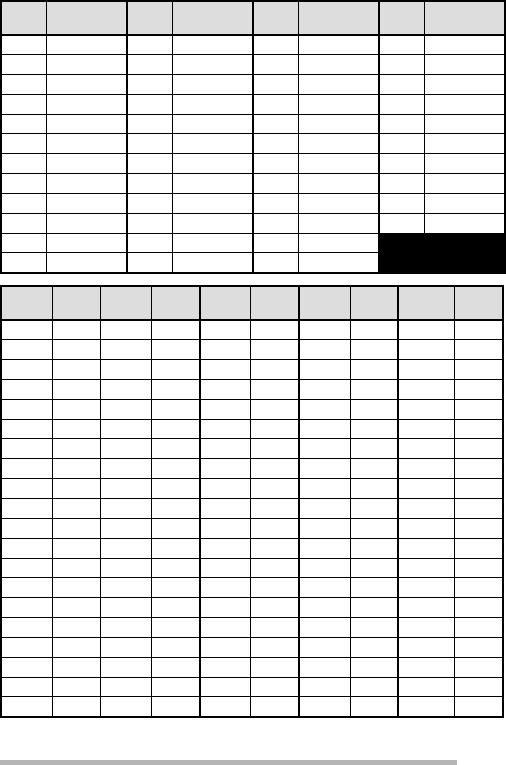
19
QT
No.
QT Frq.
QT
No.
QT Frq.
QT
No.
QT Frq.
QT
No.
QT Frq.
167.0 Hz 13 103.5 Hz 25 156.7 Hz 37 241.8 Hz
271.9 Hz 14 107.2 Hz 26 162.2 Hz 38 250.3 Hz
374.4 Hz 15 110.9 Hz 27 167.9 Hz 39 69.3 Hz
477.0 Hz 16 114.8 Hz 28 173.8 Hz 40 67.0 Hz
579.7 Hz 17 118.8 Hz 29 179.9 Hz 41 67.0 Hz
682.5 Hz 18 123.0 Hz 30 186.2 Hz 42 67.0 Hz
785.4 Hz 19 127.3 Hz 31 192.8 Hz 43 67.0 Hz
888.5 Hz 20 131.8 Hz 32 203.5 Hz 44 67.0 Hz
991.5 Hz 21 136.5 Hz 33 210.7 Hz 45 67.0 Hz
10 94.8 Hz 22 141.3 Hz 34 218.1 Hz oF OFF
11 97.4 Hz 23 146.2 Hz 35 225.7 Hz
12 100.0 Hz 24 151.4 Hz 36 233.6 Hz
DQT
No.
DQT
Code DQT
No.
DQT
Code DQT
No.
DQT
Code DQT
No.
DQT
Code DQT
No.
DQT
Code
1D023N 21 D134N 41 D306N 61 D503N 81 D734N
2D025N 22 D143N 42 D311N 62 D506N 82 D743N
3D026N 23 D152N 43 D315N 63 D516N 83 D754N
4D031N 24 D155N 44 D331N 64 D532N 84 D645N
5D032N 25 D156N 45 D343N 65 D546N 85 D023I
6D043N 26 D162N 46 D346N 66 D565N 86 D025I
7D047N 27 D165N 47 D351N 67 D606N 87 D026I
8D051N 28 D172N 48 D364N 68 D612N 88 D031I
9D054N 29 D174N 49 D365N 69 D624N 89 D032I
10 D065N 30 D205N 50 D371N 70 D627N 90 D043I
11 D071N 31 D223N 51 D411N 71 D631N 91 D047I
12 D072N 32 D226N 52 D412N 02 D632N 92 D051I
13 D073N 33 D243N 53 D413N 73 D654N 93 D054I
14 D074N 34 D244N 54 D423N 74 D662N 94 D065I
15 D114N 35 D245N 55 D431N 75 D664N 95 D071I
16 D115N 36 D251N 56 D432N 76 D703N 96 D072I
17 D116N 37 D261N 57 D445N 77 D712N 97 D073I
18 D125N 38 D263N 58 D464N 78 D723N 98 D074I
19 D131N 39 D265N 59 D465N 79 D731N 99 D114I
20 D132N 40 D271N 60 D466N 80 D732N 100 (A0) D115I
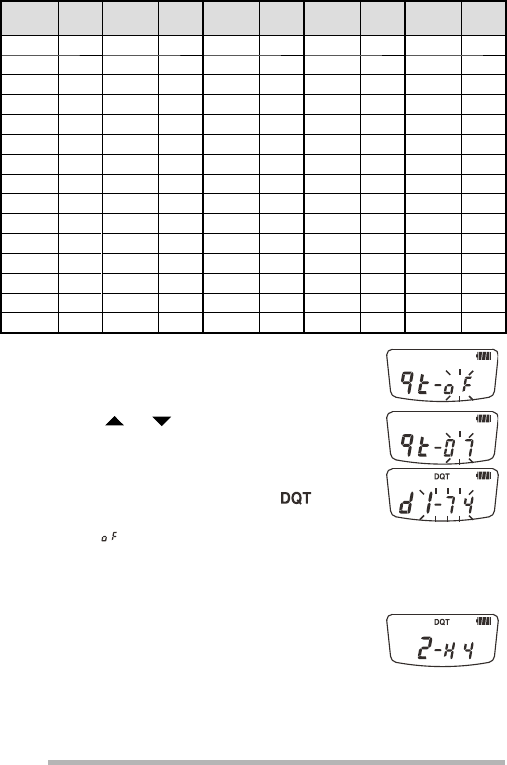
20
DQT
No.
DQT
Code DQT
No.
DQT
Code DQT
No.
DQT
Code DQT
No.
DQT
Code DQT
No.
DQT
Code
101 (A1) D116I 116 (B6) D226I 131 (D1) D351I 146 (E6) D506I 161 (G1) D712I
102 (A2) D125I 117 (B7) D243I 132 (D2) D364I 147 (E7) D516I 162 (G2) D723I
103 (A3) D131I 118 (B8) D244I 133 (D3) D365I 148 (E8) D532I 163 (G3) D731I
104 (A4) D132I 119 (B9) D245I 134 (D4) D371I 149 (E9) D546I 164 (G4) D732I
105 (A5) D134I 120 (C0) D251I 135 (D5) D411I 150 (F0) D565I 165 (G5) D734I
106 (A6) D143I 121 (C1) D261I 136 (D6) D412I 151 (F1) D606I 166 (G6) D743I
107 (A7) D152I 122 (C2) D263I 137 (D7) D413I 152 (F2) D612I 167 (G7) D754I
108 (A8) D155I 123 (C3) D265I 138 (D8) D423I 153 (F3) D624I 168 (G8) D645I
109 (A9) D156I 124 (C4) D271I 139 (D9) D431I 154 (F4) D627I 169 (G9) D023N
110 (B0) D162I 125 (C5) D306I 140 (E0) D432I 155 (F5) D631I 170 (H0) D023N
111 (B1) D165I 126 (C6) D311I 141 (E1) D445I 156 (F6) D632I 171 (H1) D023N
112 (B2) D172I 127 (C7) D315I 142 (E2) D464I 157 (F7) D654I 172 (H2) D023N
113 (B3) D174I 128 (C8) D331I 143 (E3) D465I 158 (F8) D662I 173 (H3) D023N
114 (B4) D205I 129 (C9) D343I 144 (E4) D466I 159 (F9) D664I 174 (H4) D023N
115 (B5) D223I 130 (D0) D346I 145 (E5) D503I 160 (G0) D703I oF OFF
1 Press the MENU key.
• The current setting blinks.
2 Press the or key to select your desired
value.
• The values range from 01 to 45 for QT tones,
then proceed to 01 to 174 for DQT codes.
When selecting a DQT code, the icon
appears on the display.
• Select “ ” to turn off both QT and DQT.
3 Press the MENU key 4 times, or press the PTT, MON, or
CAL key or after mode reset timer has elapsed {page 45} to
confi rm the selection and return to operating mode.
• In Channel display, If DQT No. is 100 or more,
the second digit is displayed by alphabet.

21
PRIVACY TALK
Whereas the QT and DQT functions allow you to ignore
unwanted calls, Privacy Talk allows you to hold a conversation
in complete privacy. When this function is activated, any
other party that is listening to your channel will be unable to
understand your conversation.
1 Press the MENU key 2 times.
• The icon appears on the display and
blinks.
2 Press the or key to select “ ” (privacy
on) or “ ” (privacy off).
3 Press the MENU key 3 times, or press the PTT, MON, or
CAL key or after mode reset timer has elapsed {page 45} to
confi rm the selection and return to operating mode.
TRANSMIT POWER
You can adjust the transmit power on all channels. Selecting
low power will allow longer use of the battery pack. Selecting
high power will allow you to transmit further, in case the other
party is too far away for low power usage.
To change the transmit power:
1 Press the MENU key 3 times.
• The current setting blinks.
2 Press the or key to select “ ” (low
power) or “ ” (high power).
• The icon appears on the display when low
power is selected.
3 Press the MENU key 2 times, or press the PTT, MON, or
CAL key or after mode reset timer has elapsed {page 45} to
confi rm the selection and return to operating mode.

22
COMPANDER
The compander (compressor/expander) allows higher clarity
of signals, avoiding excessive noise and interference. When
activated, transmitted signals are compressed before being
sent and received signals are expanded when they arrive.
1 Press the MENU key 4 times.
• The current setting blinks.
2 Press the or key to select “ ”
(compander off) or “ ” (compander on).
3 Press the MENU key 1 time, or press the PTT, MON, or
CAL key or after mode reset timer has elapsed {page 45} to
confi rm the selection and return to operating mode.
MONITOR
When no signals are present, the squelch on the transceiver
automatically mutes the speaker so you will not hear
background noise. Using the MON key, you can open the
squelch to unmute the speaker. This allows you to:
• confi rm the channel activity so you don’t make a call while another
party is using the same channel
• adjust the volume level without having to wait for a call
• listen to an intermittent call (due to a weak signal) without it
continuously cutting out
To manually open the squelch, press and hold the MON key.
• When squelch is open, the icon appears on the display and the
LED lights green.
To return to normal operation, release the MON key.
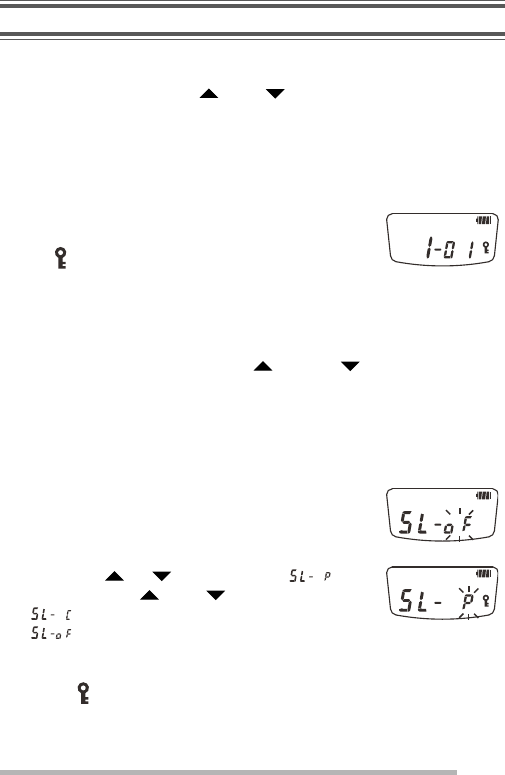
23
LOCK FUNCTION
KEY LOCK
You can lock the MENU, , and keys to prevent
accidentally changing the operating mode and channel
settings. The Power switch/ Volume control and PTT, CAL*,
and MON still function normally.
* The CAL key functions normally only if it has been set up as Call
Alert {page 33}.
Press and hold the MENU key for 3 seconds to
lock or unlock the transceiver keys.
• The icon appears on the display when the
transceiver keys are locked. No icon appears
when they are unlocked.
SUPER LOCK
You can lock the MENU, CAL*, , and/or keys, and disable
the Setting Mode. The Power switch/ Volume control, PTT and
MON still function normally.
* The CAL key will not be locked only if it has been set up as Selcall
{page 34}.
To select the super lock setting:
1 With the transceiver power OFF, press and
hold the PTT switch and the CAL key while
turning the transceiver power ON (for 1
second).
2 Press the or key to select “ ”
(MENU, CAL, , and keys locked),
“ ” (MENU and CAL keys locked), or
“ ” (super lock off).
3 Press the MENU, PTT, MON, or CAL key to exit Super Lock
Setting Mode.
• The icon appears on the display when the transceiver keys are
locked. No icon appears when they are unlocked.

24
SETTING MODE
Many functions on this transceiver are selected or confi gured
through the Menu instead of physical controls.
1 With the transceiver power OFF, press and hold the MENU
key while turning the transceiver power ON (for 1 second).
2 Press the or key to select your desired
Setting menu.
3 Press the MENU key then press or
to select your desired value for the Setting
menu.
4 Press the MENU key to exit the selection.
5 Press the PTT, MON, or CAL key to exit Setting Mode.
Setting Menu
Display Name Settings Default Ref. Pg
Channel 1 Frequency
Setting 01 ~ 99 02 26
Channel 2 Frequency
Setting 01 ~ 99 08 26
Channel 3 Frequency
Setting 01 ~ 99 09 26
Channel 4 Frequency
Setting 01 ~ 99 10 26
Channel 5 Frequency
Setting 01 ~ 99 11 26
Channel 6 Frequency
Setting 01 ~ 99 12 26
Optional Signaling OFF/ FS
(FleetSync) OFF 34
1 Individual Selcall Alert OFF/ 1 ~ 10 9 37
1 Group Selcall Alert OFF/ 1 ~ 10 10 37
2 Incoming Call
Notifi cation OFF/ ON (Tone) OFF 44
Call Key CA (Call Alert)/ SC
(Selcall)/ OFF CA 32
3 Call Alert Tone Type 1 ~ 10 1 33
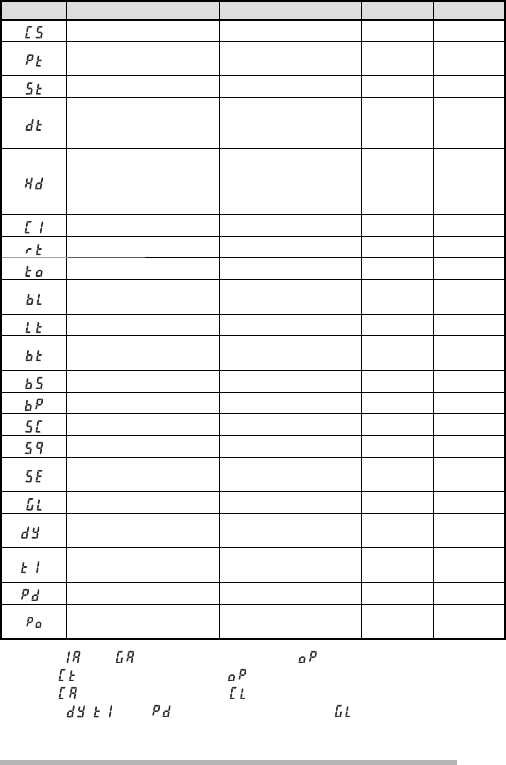
25
Display Name Settings Default Ref. Pg
Call Alert Side Tone OFF/ ON ON 33
PTT ID OFF/ bo (BOT)/ 01~
32 (List 1 ~ 32) OFF 38
PTT ID Side Tone OFF/ ON ON 39
Data Transmit
Modulation Delay
Time
0/ 5 (500)/ 10
(1000)/ 15 (1500)/
20 (2000 ms)
500 ms 38
Mute Hold Time
OFF/ 5 (500)/ 10
(1000)/ 15 (1500)/
20 (2000)/ 25 (2500
ms)
OFF 39
Caller ID Display OFF/ ON OFF 40
Mode Reset Timer OFF/ 10/ 30 sec 10 sec 45
Time-out Timer 3/ 10 min 3 min 41
Busy Channel
Lockout OFF/ ON OFF 44
Backlight
OFF/ ON/ A (Auto)
Auto 40
Battery Level
Indicator OFF/ ON ON 43
Battery Saver OFF/ ON OFF 42
Beep Tone OFF/ ON ON 45
Scan Function OFF/ ON OFF 27
Squelch Level 0/ 1/ 2 1 28
Mic Sense no (Normal)/ HI
(High) Normal 41
VOX Gain Level OFF/ 1 ~ 5 OFF 30
4 VOX Delay Time 0.1/ 0.3/ 0.5/ 1.0/
1.5/ 3.0 sec 1.0 sec 30
4 Transmit Inhibit while
Receiving OFF/ ON OFF 31
4 VOX Proceed Tone OFF/ ON OFF 31
Selectable Power ON
Tone Type 1 ~ 3 Type 1 46
1 Menus and are not available if the menu is set to OFF.
2 Menu is not available if the menu is set to FleetSync.
3 Menu is not available if the menu is set to OFF or Selcall.
4 Menus , , and are not available if the menu is set to OFF.
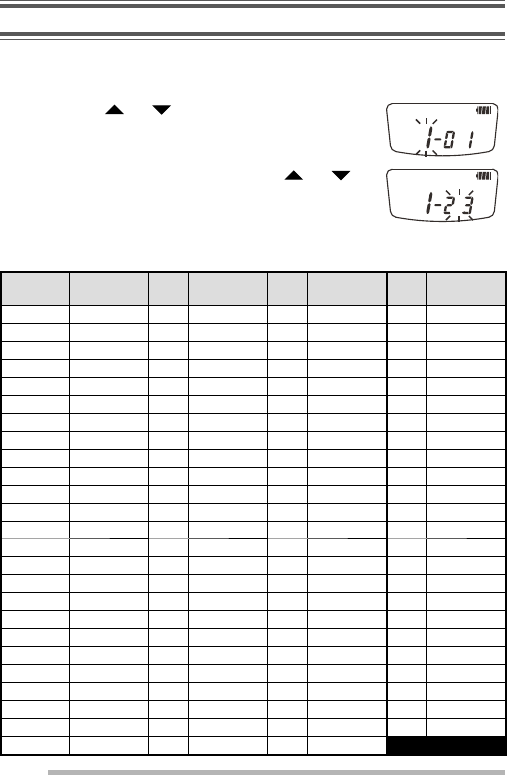
26
CHANNEL FREQUENCY SETUP
You can change the default frequency of each channel.
1 Enter the Setting Mode {page 24}.
2 Press the or key to select a channel.
• The current frequency table number appears
beside the channel number.
3 Press the MENU key then press or
to select the frequency table number for the
channel.
4 Press the MENU key to exit the selection, then repeat steps
2 and 3 to set additional channels.
Table No.
Frq.
(MHz)
Table
No.
Frq.
(MHz)
Table
No.
Frq.
(MHz)
Table
No.
Frq.
(MHz)
1464.5000 26 462.8375 51 467.8875 76 452.7625
2
(CH 1)
464.5500 27 462.8625 52 467.9125 77 452.8625
3467.7625 28 462.8875 53 469.4875 78 456.1875
4
467.8125 29 462.9125 54 469.5125 79 456.2375
5467.8500 30 464.4875 55 469.5375 80 456.2875
6
467.8750 31 464.5125 56 469.5625 81 468.2125
7467.9000 32 464.5375 57 462.1875 82 468.2625
8
(CH 2)
467.9250 33 464.5625 58 462.4625 83 468.3125
9
(CH 3)
461.0375 34 466.0375 59 462.4875 84 468.3625
10
(CH 4)
461.0625 35 466.0625 60 462.5125 85 468.4125
11
(CH 5)
461.0875 36 466.0875 61 467.1875 86 468.4625
12
(CH 6)
461.1125 37 466.1125 62 467.4625 87 468.5125
13 461.1375 38 466.1375 63 467.4875 88 468.5625
14 461.1625 39 466.1625 64 467.5125 89 468.6125
15 461.1875 40 466.1875 65 451.1875 90 468.6625
16 461.2125 41 466.2125 66 451.2375 91 456.3375
17 461.2375 42 466.2375 67 451.2875 92 456.4375
18 461.2625 43 466.2625 68 451.3375 93 456.5375
19 461.2875 44 466.2875 69 451.4375 94 456.6375
20 461.3125 45 466.3125 70 451.5375 95 457.3125
21 461.3375 46 466.3375 71 451.6375 96 457.4125
22 461.3625 47 466.3625 72 452.3125 97 457.5125
23 462.7625 48 467.7875 73 452.5375 98 457.7625
24 462.7875 49 467.8375 74 452.4125 99 457.8625
25 462.8125 50 467.8625 75 452.5125

27
• The marked CH numbers are the default channel settings.
SCAN
Scan is useful for monitoring signals on the transceiver
channels. When scanning, the transceiver checks for a signal
on each channel and only stops if a signal is present.
If the QT/DQT matches, the transceiver stops at the channel
and opens the squelch so you can listen to the call. If the
QT/DQT does not match, the call is ignored and scanning
continues.
Before you can use the scan function, ensure that it is
activated. You can turn the scan function (the ability to perform
scan) ON or OFF in Setting Mode.
1 Enter the Setting Mode {page 24}.
2 Press the or key to select “ ”.
3 Press the MENU key then press or to
select “ ” (scan function disabled) or
“ ” (scan function enabled).
• If you select “ ”, you will no longer be able to perform scan
by pressing and holding the key {page 28}.
To begin scanning:
1 Press and hold the key for 1 second.
• “ ” appears on the display.
2 When a signal is detected and the QT/ DQT matches, the
channel number appears on the display and blinks.
3 When the signal is no longer present, the transceiver waits
for 5 seconds before scanning continues.
• If a new signal appears before the 5 seconds elapse, the
transceiver will remain on the channel until the new signal is
no longer present, at which time it will again wait for 5 seconds
before continuing.
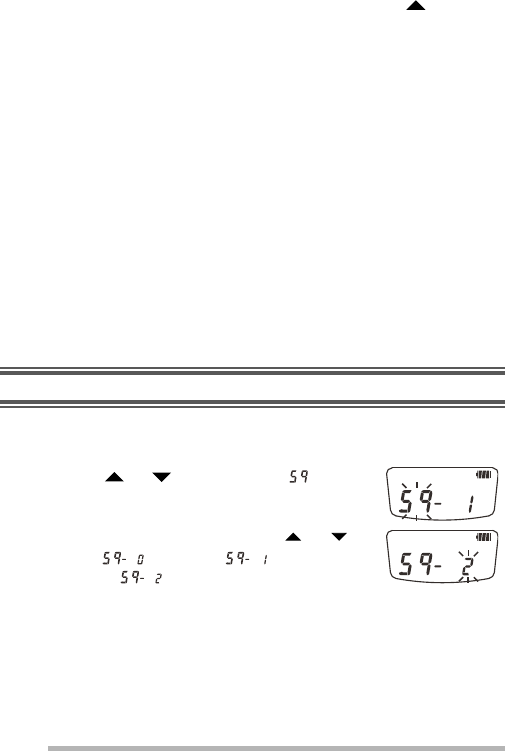
28
4 To end the scan at any time, press and hold the key for
1 second.
• The transceiver returns to the channel you were using before
you started scanning.
REVERT CHANNEL
The revert channel is the channel from which you start
scanning. So, for example, if you are on channel 1 when you
begin to scan, your revert channel is channel 1.
During scan, pressing the PTT switch will automatically select
the transceiver’s revert channel (in the above example, channel
1) and you will begin transmitting. However, if you are currently
paused on another channel after having received a signal (for
example, channel 2), pressing the PTT switch will allow you
to transmit on that channel, rather than returning to the revert
channel. Scanning will resume after 5 seconds, unless a signal
is present on the channel.
SQUELCH LEVEL
You can adjust the default squelch level of the transceiver.
1 Enter the Setting Mode {page 24}.
2 Press the or key to select “ ”.
3 Press the MENU key then press or
to select “ ” (open), “ ” (default
setting), or “ ” (tight).

29
VOICE OPERATED TRANSMISSION (VOX)
Using the VOX feature, you can operate the transceiver
hands-free. In order to use this feature, however, you must
use an optional headset; VOX will not function with the built-in
microphone. For best operation conditions, we recommend
you use an optional headset with both an ear piece and a
microphone on a boom that rests in front of your mouth.
VOX OPERATION
1 Set up a VOX gain level from 1 to 5 {page 30}.
2 To transmit, speak into the headset microphone.
• You do not need to press the PTT switch; the transceiver
automatically detects your voice and begins transmitting. The
LED lights red.
3 To stop transmitting, stop speaking.
• Transmission will continue momentarily after you stop speaking.
You can select the delay time as described on page 30.
4 To exit VOX mode, set the VOX gain level {below} to
“ ” (VOX function off).
VOX Gain Level
With VOX activated, your voice level will determine when you
transmit. Due to the automatic switching between transmission
and reception, we recommend you set the VOX gain level such
that it will not activate when in an area with excessive ambient
noise.
1 Enter the Setting Mode {page 24}.
2 Press the or key to select “ ”.
3 Press the MENU key then press or to
select “ ” (VOX function off) or “ ”
(VOX gain level 1) to “ ” (VOX gain level
5).

30
• While adjusting the VOX Gain level, speak into the microphone.
When an appropriate level is reached, the LED lights orange.
• Setting the VOX gain level to OFF deactivates VOX. In order to
transmit with VOX turned off, you must use the PTT switch.
VOX Delay Time
If the transceiver returns to receive mode too quickly after
you stop speaking, the end of your message may not be
transmitted. To avoid this, select an appropriate delay time that
allows your entire message to be transmitted. However, do not
make the delay overly long.
1 Enter the Setting Mode {page 24}.
2 Press the or key to select “ ”.
3 Press the MENU key then press or to
select “ ” (0.1 sec.), “ ” (0.3 sec.),
“ ” (0.5 sec.), “ ” (1 sec.), “ ”
(1.5 sec.), or “ ” (3 sec.).
• While adjusting the VOX Delay Time, speak into the microphone
to simulate transmitting. The LED lights orange while speaking,
but no signal is transmitted at this time.
Transmit Inhibit While Receiving
While using VOX, you can set the transceiver to detect when
the channel is in use (in place of using the Monitor function).
With this function turned on, VOX will not allow you to transmit
while the channel is being used. You can transmit only when
the channel is free. Setting up the proceed tone function will
notify you when the channel is free {below}.
1 Enter the Setting Mode {page 24}.
2 Press the or key to select “ ”.
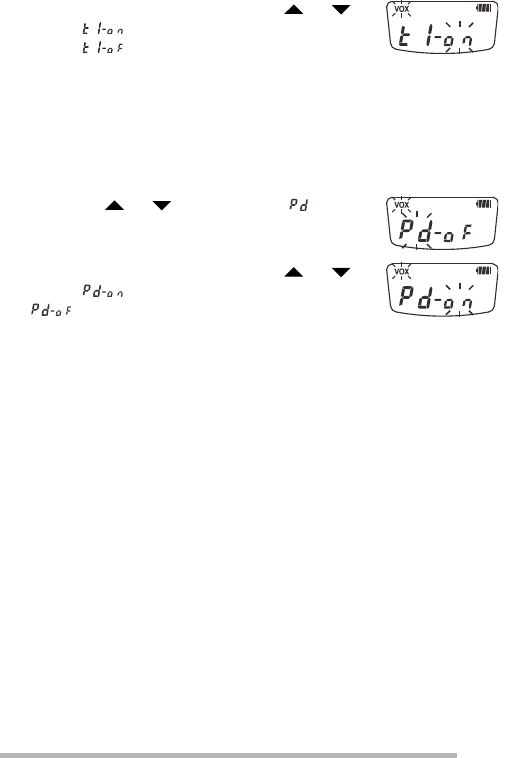
31
3 Press the MENU key then press or to
select “ ” (transmit inhibit while receiving
on) or “ ” (transmit inhibit while receiving
off).
VOX Proceed Tone
You can set the transceiver to sound an alert tone when you
are able to transmit (transmission is no longer inhibited).
1 Enter the Setting Mode {page 24}.
2 Press the or key to select “ ”.
3 Press the MENU key then press or to
select “ ” (VOX proceed tone on) or
“ ” (VOX proceed tone off).
• You can speak into the microphone at this time to simulate
transmitting. The LED lights orange while speaking if your voice
is at an appropriate level, but no signal is transmitted at this time.
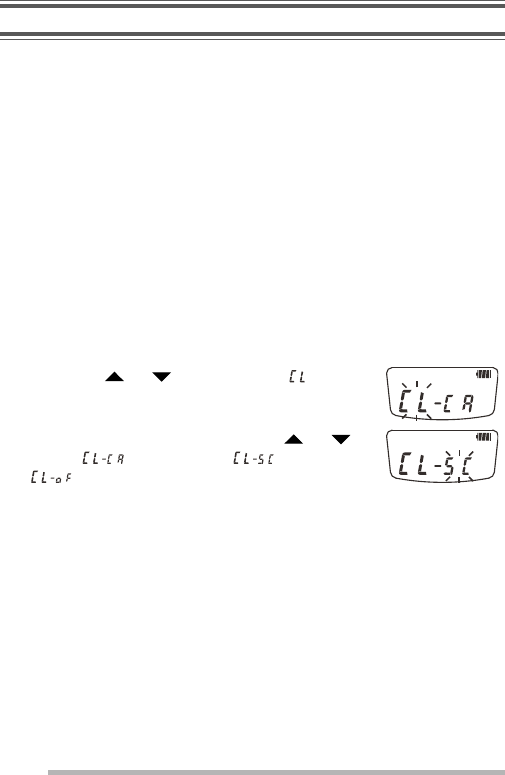
32
FleetSync: ALPHANUMERIC 2-WAY PAGING FUNCTION
FleetSync is an Alphanumeric 2-way Paging Function, and
is a protocol owned by JVC KENWOOD Corporation. Each
transceiver has a unique ID which is used to decode signals
from other callers.
CALL KEY SETUP
You can set up the transceiver CAL key to perform 1 of 2
functions, or you can turn the CAL key off (unused):
Call Alert: Press the CAL key before making a call will send
your call alert tone to your party members, identifying yourself
before speaking.
Selcall: Press the CAL key then select from a list of IDs to
make calls to specifi c transceivers.
To set up the CAL key:
1 Enter the Setting Mode {page 24}.
2 Press the or key to select “ ”.
3 Press the MENU key then press or to
select “ ” (call alert), “ ” (selcall), or
“ ” (off).

33
CALL ALERT TONE
Call alert tones are used to identify yourself to your party
members. You can set up a call alert tone to one of 10 types.
If each party member uses a different call alert tone, it is
easy to know who is making the call. Pressing the CAL key
before making a call will send your call alert tone to your party
members.
To set up your own call alert tone:
1 Enter the Setting Mode {page 24}.
2 Press the or key to select “ ”.
3 Press the MENU key then press or to
select “ ” (call alert tone 1) to “ ”
(call alert tone 10).
• Each time you press or to select a call alert tone, the new
tone sounds.
Call Alert Side Tone
When the CAL key is pressed, the call alert tone will sound
through your own speaker as well.
To turn the Call Alert Side Tone on or off, on your own
transceiver:
1 Enter the Setting Mode {page 24}.
2 Press the or key to select “ ”.
3 Press the MENU key then press or to
select “ ” (Call Alert Side Tone is on) or
“ ” (Call Alert Side Tone is off).
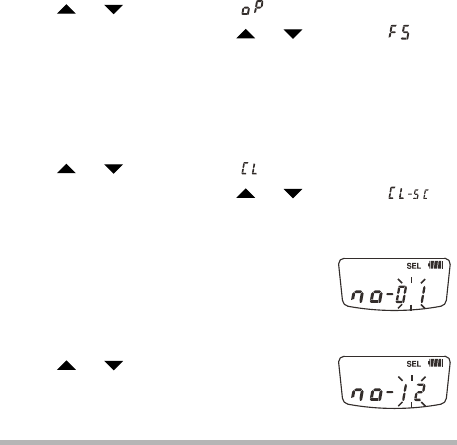
34
SELCALL (SELECTIVE CALLING)
A Selcall is a voice call to a particular station or group of
stations. Each transceiver is set up with an individual ID
number for use with selcalls.
There are several types of Selcalls available: Individual, Group,
and Broadcast.
• Individual Calls are calls made to individual parties.
• Group Calls are calls made to all parties within a group.
• Broadcast Calls are calls made to all parties in all groups.
The default status of the transceiver does not allow you to
make a Selcall. Use the following procedures to set up your
transceiver to allow Selcalls:
Step 1: Activate the FleetSync Optional Signaling
1 Enter the Setting Mode {page 24}.
2 Press the or key to select “ ” (Optional Signaling).
3 Press the MENU key then press or to select “ ”
(FleetSync).
• After setting the Optional Signaling to FleetSync, you will no
longer be able to receive calls except selcalls.
Step 2: Set up the CAL key
1 Enter the Setting Mode {page 24}.
2 Press the or key to select “ ”.
3 Press the MENU key then press or to select “ ”
(selcall).
Step 3: Set up your own ID (ID List Setting Mode for Selcall)
1 With the transceiver power OFF, press
and hold the CAL key while turning the
transceiver power ON (for 1 second).
• A beep will sound and the transceiver will enter
ID List Setting Mode.
2 Press the or key to select a list ID
number.
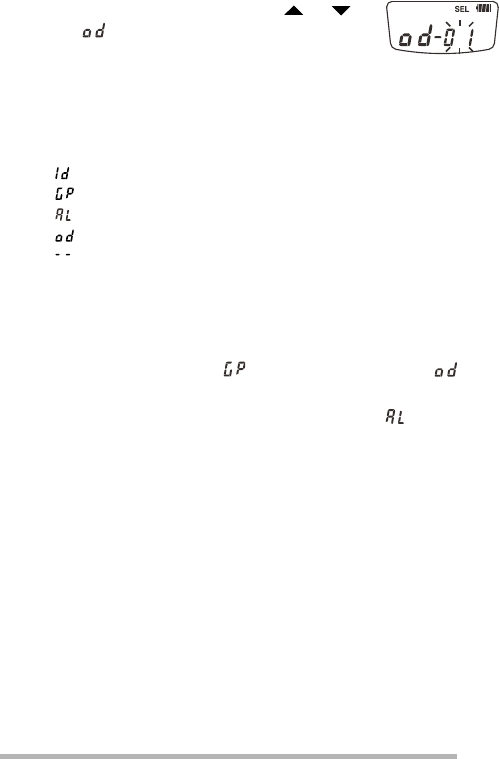
35
3 Press the MENU key then press or to
select “ ” (own ID).
• The default own ID setting is 01.
• When setting up your own ID, make sure that each member
within your group sets up a unique ID number for their own ID. If
an own ID number is duplicated, that transceiver cannot perform
selcalls.
“ ” represents an Individual Call ID.
“ ” represents a Group Call ID.
“ ” represents a Broadcast Call ID.
“ ” represents your own ID number.
“ ” clears the selected ID data.
4 Press the MENU key to confi rm the selection.
5 Press the PTT, MON, or CAL key to return to normal
operation.
6 Set up your group ID number by repeating steps 1 to 5,
above. In step 3, select “ ” (group ID) instead of “ ”.
• Ensure that all of your group members set up the same group ID.
7 You can also set up a broadcast ID number (“ ”) which is
used to make calls to all members of several groups.
• Ensure that all members of all groups set up the same broadcast ID.

36
Making a Selcall
Following are details on how to make individual, group, and
broadcast calls. Refer to the diagram below for the examples
provided herein.
Note:
◆When QT/DQT is set to the receiving side , the call side
QT/DQT settings must be set up the same as the receiving
side settings.
◆During Scan the CAL key does not operate.
Individual Calls:
For example, transceiver A is calling transceiver E.
1 Press the CAL key.
2 Press the or key to select an individual ID number (Id-
05 in this example).
• “ ” (individual call) represents a single station.
3 Press the PTT switch to transmit the selected ID.
• When a call is received, “ ” appears on the display, along with
the caller’s ID number.
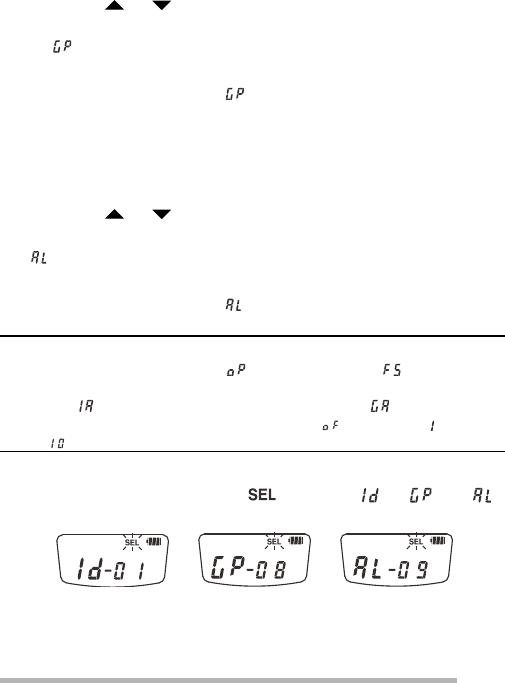
37
Group Calls:
For example, transceiver A is calling transceivers D, E, and F.
1 Press the CAL key.
2 Press the or key to select a group ID number (GP-12
in this example).
• “ ” (group call) represents a group of stations.
3 Press the PTT switch to transmit the selected group ID.
• When a call is received, “ ” appears on the display, along with
the caller’s ID number.
Broadcast Calls:
For example, transceiver A is calling transceivers B ~ F.
1 Press the CAL key.
2 Press the or key to select a broadcast ID number (AL-
15 in this example).
“
” (broadcast call) represents all stations.
3 Press the PTT switch to transmit the selected broadcast ID.
• When a call is received, “ ” appears on the display, along with
the caller’s ID number.
Note:
◆If Optional Signaling (menu “ ”) has been set to “ ”
(FleetSync), you can also set up an Individual Selcall Alert type
(menu “ ”) and Group Selcall Alert type (menu “ ”). Individual
and Group Selcall Alert types range from “ ” (off) and “ ” (type 1)
to “ ” (type 10).
Receiving a Selcall
When a selcall is received, the icon and “ ”, “ ” or “ ”
appears on the display along with the caller's ID number.
Press the PTT switch and speak into the speaker area to
respond to the call, then continue the call as normal. When the
call is fi nished, press the CAL key to return to operating mode.
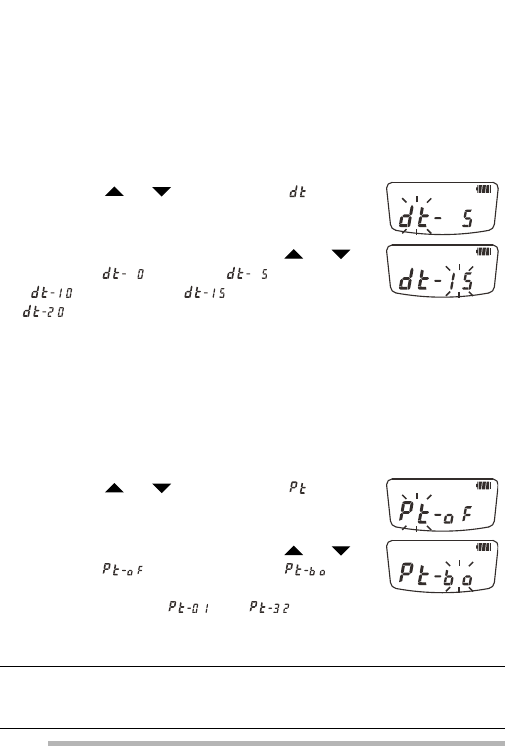
38
Data Transmit Modulation Delay Time
This function normally operates fi ne using the default setting,
so it is not necessary to adjust the value. However, there are
certain operating environments that will not allow the use of
FleetSync (Selcall) functions, such as Scan mode. When you
encounter such an environment, readjust the delay time to a
longer time by following the procedures.
To set up a data transmit modulation delay time:
1 Enter the Setting Mode {page 24}.
2 Press the or key to select “ ”.
3 Press the MENU key then press or
to select “ ” (0 ms), “ ” (500 ms),
“ ” (1000 ms), “ ” (1500 ms), or “
” (2000 ms).
PTT ID
The transceiver can send a PTT ID signal when pressing the
PTT switch (beginning of transmission) or when pressing and
releasing (beginning of transmission and end of transmission)
the PTT switch.
1 Enter the Setting Mode {page 24}.
2 Press the or key to select “ ”.
3 Press the MENU key then press or
to select “ ” (PTT ID is off), “ ”
(send your own PTT ID at the beginning of
transmission), or “ ” to “ ” (send
selected list ID number PTT ID at the
beginning and end of transmission).
Note:
◆Transceiver's individual ID number is not available for selection as
PTT ID.

39
PTT ID Side Tone
When the PTT switch is pressed and/or released, a tone
will sound through your own speaker when the PTT ID is
transmitted.
To turn the PTT ID Side Tone on or off:
1 Enter the Setting Mode {page 24}.
2 Press the or key to select “ ”.
3 Press the MENU key then press or to
select “ ” (PTT ID Side Tone is on) or “
” (PTT ID Side Tone is off).
Mute Hold Time
Mute Hold Time keeps the speaker muted for a brief moment,
after a signal has been received. This prevents interference
with the PTT ID signal.
To set the hold time:
1 Enter the Setting Mode {page 24}.
2 Press the or key to select “ ”.
3 Press the MENU key then press or to
select “ ” (hold time is off), “ ” (500
ms), “ ” (1000 ms), “ ” (1500 ms),
“ ” (2000 ms), or “ ” (2500 ms).

40
Caller ID Display
When the transceiver receives a PTT ID signal, the caller ID of
that signal appears on the display, along with the icon, so
you know who is making the call.
1 Enter the Setting Mode {page 24}.
2 Press the or key to select “ ”.
3 Press the MENU key then press or to
select
“ ” (Caller ID Display is on) or “ ”
(Caller ID Display is off).
BACKGROUND OPERATIONS
DISPLAY BACKLIGHT
You can set the display backlight to remain off, remain on, or
turn on when you press any key other than the PTT switch
(auto). When set to auto, the backlight remains on for 5
seconds after pressing a key, before turning off again.
To select the backlight setting:
1 Enter the Setting Mode {page 24}.
2 Press the or key to select “ ”.
3 Press the MENU key then press or
to select “ ” (backlight off), “ ”
(backlight on), or “ ” (backlight auto).
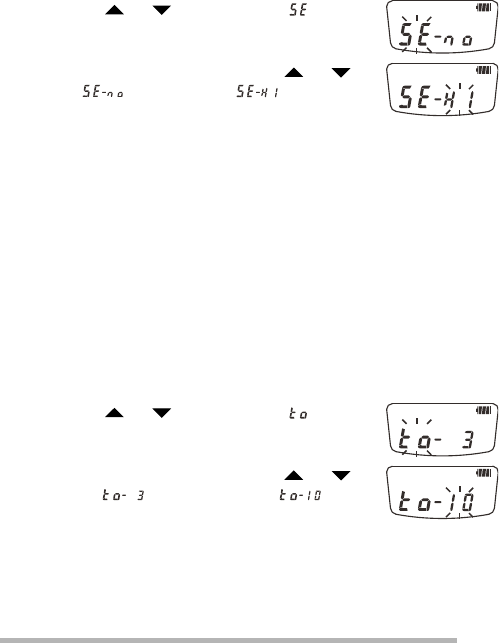
41
MIC SENSE
You can adjust the sensitivity level of the transceiver
microphone.
To select the mic sense:
1 Enter the Setting Mode {page 24}.
2 Press the or key to select “ ”.
3 Press the MENU key then press or to
select “ ” (normal) or “ ” (high).
TIME-OUT TIMER
The Time-out Timer prevents you from using a channel for a
extended durations. This function is useful, for example, when
you accidentally keep the PTT switch pressed. Additionally, by
limiting the amount of time you can continuously transmit, this
feature helps you save on battery power consumption.
If you continuously transmit for 3 minutes (default value), the
transceiver will stop transmitting and a tone will sound. To
stop the tone, release the PTT switch. You can press the PTT
switch again to resume transmitting.
To change the default value of 3 minutes:
1 Enter the Setting Mode {page 24}.
2 Press the or key to select “ ”.
3 Press the MENU key then press or
to select “ ” (3 minutes) or “ ” (10
minutes).
This transceiver is also equipped with a pre-alert tone which
sounds 10 seconds before the Time-out Timer expires. This will
allow you time to fi nish your message before the transceiver
automatically stops transmitting.
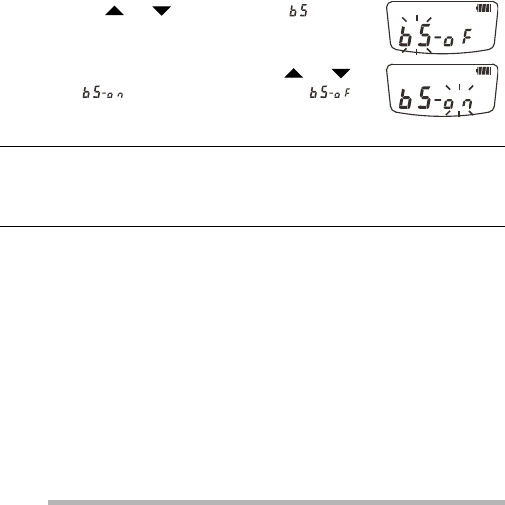
42
BATTERY SAVER
This transceiver has been designed to give you the most out of
your battery power. The battery saver function decreases the
amount of power used when a signal is not being received and
no operations are being performed.
While using the transceiver, battery saver will automatically
switch ON after 5 seconds have elapsed with no operations or
received calls. Operating the transceiver or receiving a call will
switch this feature OFF until 5 seconds of non-operation occurs
again.
To turn this function on or off:
1 Enter the Setting Mode {page 24}.
2 Press the or key to select “ ”.
3 Press the MENU key then press or to
select “ ” (battery saver on) or “ ”
(battery saver off).
Note:
◆While the Battery Saver is operating, the LED may fl ash green when
receiving a QT/DQT signal which does not match the QT/DQT tone/
code set up in your transceiver.

43
BATTERY LEVEL INDICATOR
When turned ON, the battery level indicator on the display lets
you know approximately how much battery life is remaining.
When turned OFF, the battery level indicator will appear and
blink only when the battery voltage level is low.
When the battery voltage becomes too low while transmitting,
the transceiver stops transmitting, a tone sounds, and the
LED blinks red until you release the PTT switch. Recharge or
replace the battery pack at this time.
High battery power
Medium battery power
Low battery power
Recharge the battery pack
To turn this function on or off:
1 Enter the Setting Mode {page 24}.
2 Press the or key to select “ ”.
3 Press the MENU key then press or to
select “ ” (battery level indicator on) or “
” (battery level indicator off).
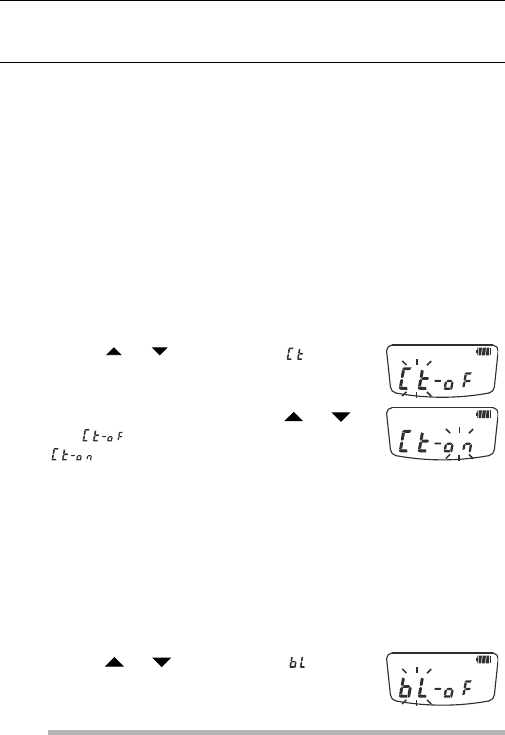
44
INCOMING CALL NOTIFICATION
Note:
◆To use Incoming Call Notifi cation, you must set up a QT tone or a
DQT code {page 18}.
Incoming Call Notifi cation is used to inform you of when a call
is being received. When activated, a tone is emitted when a
busy signal is received and the QT/ DQT signaling matches.
• The tone will sound for 15 seconds before turning off.
• While the tone sounds, you will not hear any audio from the speaker.
Press any key to turn the tone off and listen to the received call.
After the call is fi nished, the transceiver will wait for 10 seconds
before resetting. If you receive a new call within those 10
seconds, the tone will not sound. If no call is received within 10
seconds, Incoming Call Notifi cation will reset so that the next
time a call is received, the tone will sound again.
To turn Incoming Call Notifi cation on or off:
1 Enter the Setting Mode {page 24}.
2 Press the or key to select “ ”.
3 Press the MENU key then press or to
select “ ” (incoming call notifi cation off),
or “ ” (incoming call notifi cation on).
BUSY CHANNEL LOCKOUT (BCL)
This function is used in order to prevent transmitting on a
channel that somebody else is currently using. When turned
ON, a beep sounds when you press the PTT switch while
another party is using the channel, and you cannot transmit.
To turn BCL on or off:
1 Enter the Setting Mode {page 24}.
2 Press the or key to select “ ”.

45
3 Press the MENU key then press or to
select “ ” (BCL on) or “ ” (BCL off).
BEEP TONE
When you press a key, a beep will emit from the transceiver.
To turn the beep tone on or off:
1 Enter the Setting Mode {page 24}.
2 Press the or key to select “ ”.
3 Press the MENU key then press or
to select “ ” (beep tone on) or “ ”
(beep tone off).
MODE RESET TIMER
This function returns the transceiver to the channel display
after a preset timer expires while in Setting mode or ID List
mode.
To set the mode reset timerr:
1 Enter the Setting Mode {page 24}.
2 Press the or key to select “ ”.
3 Press the MENU key then press or
to select “ ” (timer off), “ ” (10
seconds), “ ” (30 seconds).

46
SELECTABLE POWER ON TONE
You can set up a tone sound during power on to one of 3 types.
To set the power on tone type:
1 Enter the Setting Mode {page 24}.
2 Press the or key to select “ ”.
3 Press the MENU key then press or to
select “ ” (type 1), “ ” (type 2),
“ ” (type 3).
RESETTING THE TRANSCEIVER
At some point in time, you may desire to reset the transceiver
settings to their default values. (Default values are listed on
pages 24 ~ 25.)
To reset the transceiver:
1 With the transceiver power OFF, press and
hold the , , and MON keys while turning
the transceiver power ON.
• “ ” (reset) will appear on the display.
2 Release the , , and MON keys.
• The confi rmation message “ ” (sure) will
appear on the display.
3 Press the PTT switch to reset the transceiver.
• Press any other key to cancel the reset.
Note:
◆Reset will function even if Super Lock has been activated.

47
TROUBLESHOOTING GUIDE
Problem Solution
Cannot turn the
transceiver power
ON.
• The battery pack may be dead. Recharge or
replace the battery pack.
• The battery pack may not be installed
correctly. Remove the battery pack and
install it again.
Battery power
dies shortly after
charging.
• The battery pack life is fi nished. Replace
the battery pack with a new one.
Cannot talk to
or hear other
members in your
group.
• Make sure you are using the same
frequency and QT/DQT setting as the other
group members.
• Other group members may be using Privacy
Talk. Turn on your transceiver’s Privacy Talk.
• Other group members may be too far away.
Make sure you are within range of the other
transceivers.
Other voices
(besides group
members) are
present on the
channel.
• Change the QT/DQT settings. Make sure
all group members change the settings on
their transceivers to match the new QT/DQT
setting.
You cannot make a
selcall.
• Verify and set your transceiver ID (Own,
Group, All).
You cannot receive
calls except
selcalls.
You cannot transmit
even by pressing
the PTT switch.
• Optional Signaling is set to "FS (FleetSync)".
Change the setting to "oF (OFF)".
The transceiver
is malfunctioning
for no apparent
reason.
• Reset the transceiver as described on page
46.

48
SPECIFICATIONS
RF output power High 1.5 W
Low 500 mW
Audio output power 100 mW
Frequency stability ±2.5 ppm
Operating voltage 3.7 V
Dimensions (W x D x H)
(projections not included)
52 x 29.6 x 103.5 mm
(2.05 x 1.17 x 4.07 in)
Weight (with KNB-46L) 155 g (5.5 oz)
© 2016